7.1 Electronic communication
|
Previous
Chapter 6: System software and computer management
|
Next
Chapter 8: Social implications of e-communications and technologies
|
 CHAPTER OVERVIEW
CHAPTER OVERVIEW
| Unit 7.1 | Electronic communication |
| Unit 7.2 | Web browsers |
| Unit 7.3 | Computer communications |
| Unit 7.4 | Communication devices |
 By the end of this chapter, you will be able to:
By the end of this chapter, you will be able to:
- Explain what digital communication is.
- Identify and discuss the different types of digital communication.
- Describe the most common features of a web browser.
- Discuss some of the most popular communication devices.
- List and describe the uses of computer communications.
INTRODUCTION
In this chapter, we will take a look at how the internet and the world-wide web are used to connect people around the world, as well as the tools that make this possible. We will start by discussing digital communication and communication devices. Thereafter, we will identify and discuss some of the most common and useful features of web browsers. Finally, we will take a look at the some of the social implications related to digital communications.
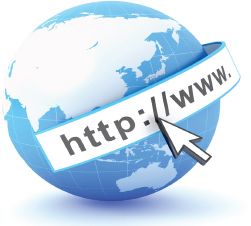
UNIT
7.1 Electronic communication
In previous years, you learned that digital or electronic communication refers to any data, information, words or photos that are sent electronically in order to communicate with one or more people. This includes calls, messages, group chats, emails, social networks and websites. These methods of electronic communication have made our lives much easier and enabled us to communicate with people around the world. However, they do have some flaws and risks that you need to be aware of.
ADVANTAGES OF ELECTRONIC COMMUNICATION
- Speedy transmission: It requires only a few seconds to communicate through electronic media because it supports quick transmission.
- Wide coverage: The world has become a global village and communication around the globe requires only a second.
- Low cost: Electronic communication saves time and money. For example, text SMS is cheaper than the traditional letter.
- Exchange of feedback: Electronic communication allows the instant exchange of feedback. So communication becomes perfect using electronic media.
- Managing global operation: Due to the advancement of electronic media, business managers can easily control operation across the globe. Video or teleconferencing e-mail and mobile communication are helping managers in this regard.
DISADVANTAGES OF ELECTRONIC COMMUNICATION
- The volume of data: The volume of telecommunication information is increasing at such a fast rate that business people are unable to absorb it within the relevant time limit.
- The cost of development: Electronic communication requires huge investment for infrastructural development. Frequent change in technology also demands further investment.
- Legal status: Data or information, if faxed, may be distorted and will cause zero value in the eye of law.
- Undelivered data: Data may not be retrieved due to system error or fault with the technology. Hence required service will be delayed.
- Dependency: Technology is changing every day and therefore poor countries face the problem as they cannot afford the new or advanced technology. Therefore poor countries need to be dependent towards developed countries for sharing global network.
ELECTRONIC COMMUNICATION BEST PRACTICES
When you communicate on the internet – whether it is via email, instant messaging, or posting a blog – it is important that you follow proper netiquette. This will not only make the internet a more pleasant place for everyone else, it will also save you from potential embarrassment in the future!
GUIDELINES WHEN COMMUNICATING ON THE INTERNET
- Texting (messaging):
- Keep texts short
- Longer texts can be misinterpreted
- Sign a text with your name
- Spell out all words and do not use “texting lingo” or shorthand
- Texts can be saved and can be altered
- Email:
- Use a descriptive subject line
- Be courteous
- Reply promptly – but allow yourself time to get over an initial reaction to an angry email
- Remember attachments to an email may contain metadata that can disclose unwanted information to the recipient
- Social Media:
- There is no expectation of privacy on the internet
- Change your passwords frequently
- Log off after visiting the page
- Delete your browsing history, saved passwords and cookies regularly
- Do not disparage anyone via social media
- Educate yourself about a site before joining.
While the tips covered in this section are generally good guidelines, it is important to note that netiquette differs from site to site and changes over time. Find out what is acceptable behaviour on that website before sending your own messages.
TYPES OF ELECTRONIC COMMUNICATION
With the advances in computer technology and the internet, there are many new and exciting ways to communicate; from sending instant messages on social network sites, to email. In this section, we will discuss the most popular types of digital communications, their advantages, as well as their disadvantages.

Something to know
Asynchronous communication means that a message can be sent without the message receiver being available at the time. Most messaging applications are asynchronous. Most phone call applications, however, are synchronous.
Email is one of the first and most popular forms of electronic communication. It allows the user to send and receive files and messages over the internet, and can be used on a wide variety of devices. Here are some of the advantages and disadvantages of email.
ADVANTAGES OF EMAIL
- Email is a free tool.
- Email is quick. Once you have finished composing a message, sending it is as simple as clicking a button. Once it is sent and delivered, it can be read almost immediately.
- Email is simple. It is easy to use, email allows for the easy and quick access of information and contacts.
- Email allows for easy referencing. Messages that have been sent and received can stored, and searched through safely and easily.
- Email is accessible from anywhere – as long as you have an internet connection.
- Email is paperless, and therefore, beneficial for the planet.
- Email allows for mass sending of messages, you can send one particular message to several recipients all at once.
- Email allows for instant access of information and files.
DISADVANTAGES OF EMAIL
- Email could potentially cause information overload. Some messages may be dismissed or left unread, especially if there are a lot coming in and the network has not integrated some sort of email alert system into the computers at work.
- Email lacks a personal touch.
- Email can be disruptive. Going through each email can be disruptive to work as it does require a bit of time. This disruption is decreased through the utilisation of an email alert system.
- Email cannot be ignored for a long time.
- Emails can cause misunderstandings. Because email does not include nonverbal communication, recipients may misinterpret the sender’s message. This is particularly true of senders fail to go through their messages before they send them.
- Email messages can contain viruses. It’s best to be aware of this possibility so that you are careful when opening messages from people you don’t know, or when downloading attachments.
- Email should be kept short and brief. This is especially difficult if you are one to send messages that are too long.
- Email requires timely responses. While some people tend to disregard messages, those that require responses should be replied to as soon as they are received and read. If not, urgent and important messages may be left untended.
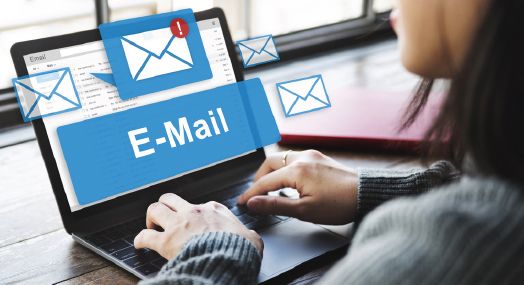
When communicating by email, always note the following:
- Be polite.
- Do not write emails that are unnecessarily long.
- Do not spam people with emails that they are not interested in.
- Make sure that your message is logical and says what you intended to say.

Something to know
Asynchronous communication means that a message can be sent without the message receiver being available at the time. Most messaging applications are asynchronous. Most phone call applications, however, are synchronous.
SOME ADDITIONAL FEATURES
Email is not limited to only sending messages over the internet; it provides users with many features. We will now take a look at each of these in some more detail.
CALENDAR
Google Calendar is a time-management and scheduling calendar service developed by Google. It became available in beta release April 13, 2006, and in general release in July 2009, on the web and as mobile apps for the Android and iOS platforms.
Google Calendar allows users to create and edit events. Reminders can be enabled for events, with options available for type and time. Event locations can also be added, and other users can be invited to events. Users can enable or disable the visibility of special calendars, including Birthdays, where the app retrieves dates of births from Google contacts and displays birthday cards on a yearly basis, and Holidays, a country-specific calendar that displays dates of special occasions.
Over time, Google has added functionality that makes use of machine learning, including “Events from Gmail”, where event information from a user’s Gmail messages are automatically added to Google Calendar; “Reminders”, where users add to-do activities that can be automatically updated with new information; “Smart Suggestions”, where the app recommends titles, contacts, and locations when creating events; and “Goals”, where users enter information on a specified personal goal, and the app automatically schedules the activity at optimal times.
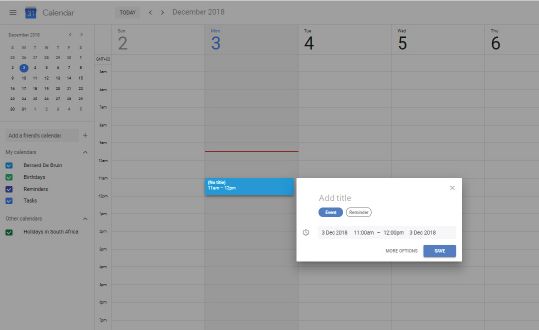
CONTACT LIST
You can now get to the contacts page by clicking the Apps icon in the upper right corner of the Gmail inbox. When you click the Apps icon, which is a square made up of nine smaller squares, it unfolds to reveal a panel of icons for other Google programs and services, including Google Photos, Google News and YouTube.
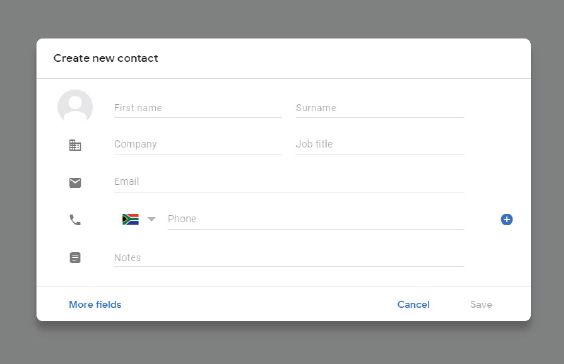
TASKS
Gmail integrates a simple to-do list into your account. Google Tasks allows you to create lists of items, set due dates, and add notes. You can even create tasks directly from Gmail messages.
To add a task in in your Gmail account using Google Tasks, click the down arrow on the “Mail” menu in the upper-left corner of the Gmail window and select “Tasks.”
The “Tasks” window displays in the bottom-right corner of the Gmail window. Notice that the cursor is blinking in the first blank task. If the cursor is not blinking in the first empty task, move the mouse over it and click in it. Then type directly in the first blank task.
Once you’ve added a task, you can click the plus icon to create additional tasks. Pressing return after entering a task also creates a new task directly below it.
ARCHIVES
Rather than deleting an email and losing it for good, you can choose to archive it instead. As soon as a message is placed in the Gmail archive, it is removed from your inbox and tagged with the label All Mail. These messages remain in your Gmail account and can be retrieved easily at a later time, but in the meantime, they are out of sight and out of mind.
When someone replies to an archived message, it automatically returns to your inbox.
Sending a message to your Gmail archive is easy, so much so that some people mistakenly archive emails by clicking on or tapping the wrong option. Fortunately for them, retrieving archive messages is almost as easy as archiving them in the first place.
INSTANT MESSAGING
Instant messaging refers to short messages that are sent in real time over the internet. The messages can include multimedia items, such as pictures, videos and voice recordings.
ADVANTAGES OF INSTANT MESSAGING
- Messages are free to send
- Messages are received directly after being sent
- You can see if the message has been delivered
- You can see when your message has been read
- You can send a variety of messages; including text messages, pictures, videos, music and web links
- You can create group conversations in order to discuss a specific topic or plan events
DISADVANTAGES OF INSTANT MESSAGING
- Messages are not always saved
- It is an informal method of communication and might not be suited for business-related communications
- There is a pressure to respond immediately as people can see when you read their messages
- Can be distracting as one message can lead to a whole conversation
- Low security, as instant messaging services use a public network
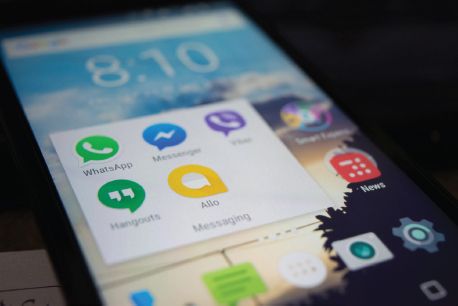
When communicating by instant messaging, take note of the following:
- Do not expect an immediate reply. The person you are messaging might be busy and will reply once he or she is available.
- Keep your messages short and to the point.
- Do not type your messages using uppercase as it can be interpreted as shouting.
- Be polite.
- Do not use slang words and abbreviations. This might save you time, but it can also confuse others if they are not aware of the meaning.
VOIP
VoIP is a type of digital communication that allows the user to speak with one or more users over the internet. This type of communication is very similar to a phone call, with the exception being that it uses your internet connection and, therefore, uses data. Here are some of the advantages and disadvantages of VoIP.
ADVANTAGES OF VOIP
- VoIP is much cheaper than using traditional telecommunication services
- It can help with productivity as you can have face-to-face meetings with colleagues in different cities
- It saves time and money as you can have face-to-face business meetings without having to travel to the client
DISADVANTAGES OF VOIP
- You need an active internet connection
- Audio quality depends on the quality of your internet connection
- Some VoIP programs use large amounts of data
When communicating using VoIP, take note of the following:
- Be polite and speak clearly.
- Indicate that you are listening to the person with whom you are speaking.
- Repeat important details to ensure that you understand them correctly.
- Do not be afraid to ask questions if something is not clear.
VIDEO CONFERENCING
- Everyone can see you, all the time. This is not an audio conference, just because you are not speaking does not mean others in the conference can’t still see you.
- Be punctual and courteous. Introduce yourself and take note of other attendees’ names so you can address them by name. Turn off ringers for your other phones. Treat this just like you would an on-site meeting.
- No multi-tasking, we can see you. Look at your screen, pay attention to others and when speaking make sure to look at your camera.
- If it is improper for a face-to-face meeting, then it doesn’t work for video either. Don’t click your pen, tap on your desk or anything else annoying or distracting. Avoid yawning, gum chewing, etc.
- Make sure you have good light. Adjust lighting or use a portable light source to make sure you have good light shining at you from the front. You can overdo it too, so experiment until you find a good balance. Try pointing a strong desk lamp at the wall you’re facing. You get good front light without having to look directly into a harsh light.
- Do not eat! You may enjoy a glass of water or coffee, but drinking a glass of wine or a bottle of beer is not acceptable. Do not smoke during the meetings either.
- Video allows us to do face-to-face meetings right from our virtual office. Even though we all enjoy sitting in a short and t-shirt in our virtual offices, it is not appropriate when you are called into a virtual meeting. Business casual at all times is the new rule. If you have a planned customer call you should consider dressing the same as you would for an on-site meeting.
- Do video calls from your desk or other appropriate location. Lying on the couch (or anywhere) with your pc on your chest or stomach doesn’t present a flattering view.
- If you have a cluttered work space, make sure it’s not showing up on camera. Consider removing award plaques from other (competitor) companies on your wall.
- Make sure to have current client version loaded before scheduled calls. Test your audio and/or video before a scheduled call.
- Avoid high traffic areas. Sometimes it’s hard to avoid but do not position yourself where other people will be parading through the view of the camera on a regular basis.
- Close unused applications, video can be CPU/memory intensive.
- Avoid creating pixilation! Do not wear stripes, or anything with a heavy pattern. If you have vertical mini-blinds do not have them in the background. Minimise your hand gestures and body/head movements as well.
- Consider posting your comment/question in the chat window.
- Picture in Picture is your best reference, you can see yourself and your surroundings just as others on the call can. Pay close attention to what you see there, and make adjustments as necessary.
- DO NOT video while driving.
 Activity 7.1
Activity 7.1
1.Write down the correct answer for each of the following questions.
a.Which of the following is NOT an additional email feature?
A.Contact list
B.Calendar
C.Tasks
D.Voice calls
b.Which of the following is NOT a type of electronic communication?
A.Instant messaging
B.Posting a letter
C.Email
D.Video conferencing
c.Which of the following is the most common netiquette when using electronic communication?
A.Be polite
B.Be there
C.Mute everyone
D.Explain everything thoroughly.
2.Choose a term or concept from Column B that matches the description in Column A. Write only the letter next to the question number.
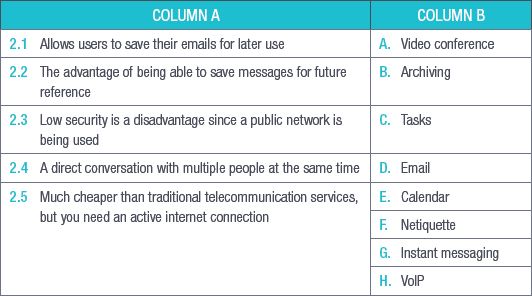
3.Say if the following statements are TRUE or FALSE. Correct the underlined word(s) if it is false.
a.Do not say things to people you would not say to them in real life.
b.On the internet, there is no need to show people respect.
c.When joining an existing conversation, speak about the subjects relevant to you.
d.Make sure your messages are clearly written and easy to understand.
e.Things posted on the internet do not last forever. This means that things you post as a teenager or young adult will not affect the rest of your life.
4.Answer the following questions:
a.Explain the world wide web to your peer.
b.List the disadvantages of electronic communication.
c.Explain the advantages of email.
d.Define ‘netiquette’ and describe proper netiquette when communicating on email.
4.VoIP software, such as Skype, is becoming increasingly popular to use.
a.Give TWO reasons why more people are currently using Skype than in the past.
b.Give ONE reason why the video and sound quality is sometimes poor when using Skype to make a video call.
c.Suggest ONE way in which the sound quality of a VoIP call can be improved without ending the session or changing any hardware.
UNIT
7.2 Electronic communication
Web browsers are software applications that allow users to access information on the world-wide web. This is done by allowing users to open and view web pages containing images, videos, text, as well as links to other web pages. The most common web browsers include Microsoft Edge, Google Chrome, Safari and Firefox.
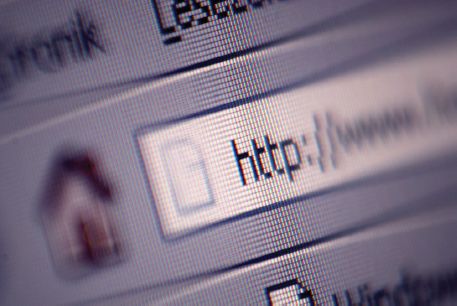
In the following section, we will look at some of the features that have been included in web browsers to help make your internet browsing experience as safe and as enjoyable as possible.

Something to know
Some web browsers, for example Internet Explorer, use the term “Favourites” instead of “Bookmarks”. Do not be alarmed by this, as they perform the same function.
BOOKMARKS
When you think of a bookmark, you most likely think of a piece of paper or card that you place in a book in order to mark the page you are currently reading. This same principle applies to the bookmarks used in your internet browsers. A bookmark is a saved shortcut that tells your browser to go to a specific website address. This saves the user the effort of having to remember and type the website address or URL each time he or she visits the page.
Depending on your web browser, you can also bookmark a web page by clicking on the star icon to the right of the website URL. This will automatically add the address to your bookmarks.
To add a new bookmark in Firefox 4, the latest version of Mozilla’s Web browser, click on the star-shaped icon next to the website URL, located in the address bar at the top of the browser window. This adds the website currently opened to the list of bookmarks. To view bookmarks, click on the book-shaped icon with the star on it, located on the top right of the browser window.
bookmarks, click on the wrench-shaped icon at the top right of the browser window (next to the star-shaped icon). Select “Bookmark Manager” from the drop-down menu.

Something to know
Most browsers contain a section called Recently closed. This section forms part of your browser history and is a list of the web pages that you recently viewed and closed.
To add a bookmark in Apple Safari, click the “Bookmarks” menu at the top of the browser window, then select “Add Bookmark” from the drop-down menu. Click the “Add” button. This adds the website you’re currently browsing to your bookmarks. To view a list of saved bookmarks, click the “Bookmarks” menu at the top of the browser window and select “Show All Bookmarks.”
To add a bookmark in Google Chrome, click on the star-shaped icon located in the address bar at the top of the browser window. A dialogue box appears to confirm the new bookmark. Click “Done.” This adds the website currently opened to the list of bookmarks. To view
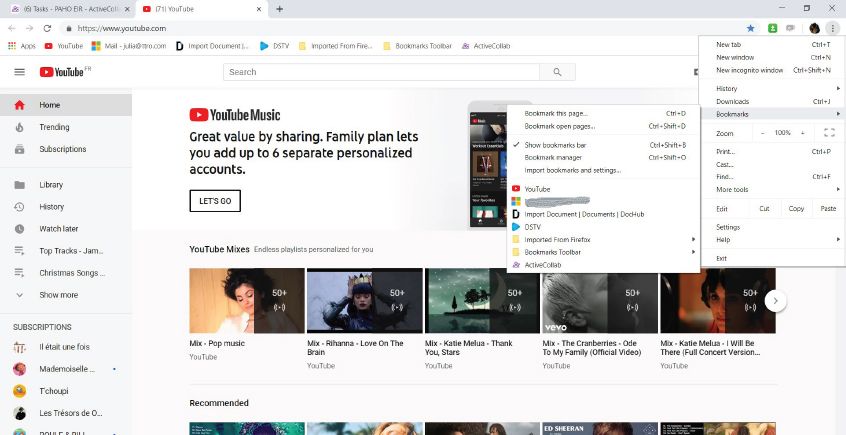
HISTORY AND FAVOURITES
History list organizes the list of webpages that are visited over a period of time by category. History List contains the URLs for the websites and page that visited through internet explorer browser. The history will save the list of webpage URL’s by Today, Yesterday, Two weeks ago and Three weeks age and so on to easily find the date and URL of the visited page on that particular date.
Favourites saves them like if you click add to favourites in the options with the particular webpage open; then it adds the website you are currently browsing to your favourites list.

Something to know
To access the History function in Google Chrome:
- Click the Open menu icon.
- Go down the menu and click History. This should open a new window containing your web-browsing history.
- Scroll down the list of websites and select the one you are looking for.
IMPORTING FAVOURITES AND BOOKMARKS
Import your favourites or bookmarks from one browser to another if you’re switching browsers or would like to use more than one. To import bookmarks or favourites into Firefox 4, open Firefox and press the “Alt” key to temporarily bring up the “File” menu. Click the “File” menu and select “Import.” An “Import Wizard” is then displayed. Select the browser from which you wish to import bookmarks or favourites and click “Next.” Select which items to import and click “Next.”
To import bookmarks as favourites in Internet Explorer 9, click on the star-shaped icon on the top right of the browser window. Click on the down-pointing arrow next to “Add to favourites” and select “Import and Export.” Select “Import from another Browser” and click “Next.” Tick the box next to the name of the browser from which you wish to import bookmarks and click “Import.”

Something to know
To activate the ad blocker in Google Chrome:
- Click the Menu icon.
- Go down the menu and click Settings. This should open a new tab in your web browser.
- Scroll to the Privacy and security options and click Control Settings. This will take you to a new menu.
- Scroll down the menu and click Pop-ups and redirects.
- Select the Blocked (recommended) checkbox. You can now close the tab, as the settings are automatically saved..
HOME PAGE SETTINGS
A home page is a webpage that serves as the starting point of website. It is the default webpage that loads when you visit a web address that only contains a domain name. For example, visiting https://techterms.com will display the Tech Terms home page.
SET YOUR HOME PAGE
You can customize Google Chrome to open any page for the homepage or startup page. These two pages aren’t the same unless you set them to be.
- Your start up page is the one that shows when you first launch Chrome on your computer.
- Your homepage is the one you go to when you click Home .
CHOOSE YOUR HOMEPAGE
You can control what page appears when you click Home.
- On your computer, open Chrome.
- At the top right, click More and then Settings.
- Under “Appearance,” turn on Show Home button.
- Below “Show Home button,” choose to use the New Tab page or a custom page
- The Home button will appear to the left of your address bar.

Something to know
Websites can also be blocked by changing the settings on your router, using specific software and through Windows. If you want to block a website using Google Chrome, you can download a browser plug-in from the Chrome web store.
BLOCKING WEBSITES
Website Blocking is a process by which a Firewall or WW Proxy prevents users from accessing some network resources, such as Word Wide Web sites or FTP servers.
Site Blocking is a legally dangerous practice, since it prevents the organisation that employs it to effectively argue that their Internet connection constitutes a Common carrier. This may make the organisation liable for offensive or illegal documents downloaded from the Internet.
HOW TO BLOCK WEB SITES IN GOOGLE CHROME
Do you find yourself accessing Facebook, Twitter, or other distracting websites when you really should be doing something else instead? Block that website in Google Chrome. Other solutions will let you block websites for children at home or employees, too.
We recommend Block Site for Chrome for quickly blocking websites. Install it, and you can use the extension’s simple options to define a list of blocked sites. You can even set up a redirection, so you’re automatically pointed at a website you should be using (perhaps your workplace’s website) when you visit a blocked site. Or, enable it on a schedule so you can look at Facebook all you want—as long as it’s outside of the hours you should define.
This isn’t fool proof. In fact, it’s the opposite. You can quickly edit Block Site’s permissions to unblock websites. And, while you can define password protection, anyone using your computer could open any other web browser to get around the block. It’s a way to keep yourself on track and add some additional friction before you access a website—that’s all. It’s not a way to control access to websites for children at home or employees in an organisation
If you don’t want an extension like Block Site to run on every website you visit, you can use Google Chrome’s extensions permissions to restrict its access. For example, if you just want to block Facebook, you could restrict Block Site to only run on facebook.com.

Something to know
If you are using a Windows operating system, then the folder used for the web cache is known as Temporary Internet Files.
CACHING
Caching is the temporary storage of web documents such as HTML pages and images. Basically your web browser stores copies of web pages you’ve visited recently to reduce its bandwidth usage, server load, and lag.
This could be why our website is offline, why it seems like your name servers still aren’t set, or why you can’t see the changes you’ve made to your website.
If you suspect this is the case, you can first try clicking “refresh” on your browser a few times. If this still does not work, you can clear your browser’s cache to see if that is the problem. Each browser is different, but here are some links to the most popular browsers cache clearing instructions:
- Chrome
- Firefox
- Safari
- Internet Explorer
- Opera
Another good tip is to visit the website on a device after turning OFF the wifi. This should get you a real-time view page and confirm a local caching issue on the original machine.
BROWSER PLUG-INS
A plugin is a piece of software that acts as an add-on to a web browser and gives the browser additional functionality. Plugins can allow a web browser to display additional content it was not originally designed to display.
An example of a plugin is the free Macromedia Flash Player, a plugin that allows the web browser to display animations using the Flash format. As the Web has become more commercial, Flash has become a popular format for displaying ads in web pages. As a result, many web users have been prompted to download the Flash plug in and have it installed on their systems.
Other popular plugins include Quicktime Player (available on the Apple website) and Acrobat Reader (which in addition to being a plugin for the major browsers is also a stand-alone application used to display files using the PDF format).
Most plugins are available as free downloads. To install the plugin, you visit the website of the plugin’s developer and click on a link that will download the installer for the plugin you have selected. You can save the installer to an easy to find location such as the Desktop or a specific folder you have created to organize all of your downloads. Once you have downloaded the installer, you can open it and follow the prompts to install the plugin on your system. You may have to restart your web browser to enable the additional functionality provided by the plugin.
POP UP BLOCKERS
Pop-ups are frequently used by websites to advertise products or features. They are therefore meant to be as eye-catching as possible. This is achieved by making the pop-up open in a small secondary window, which becomes the active window. To get the maximum amount of attention, a pop-up may also feature bright colours, animation and motion. For browsers that support tabbed browsing, the pop-up may open in a secondary tab instead of a whole new window. Pop-ups are commonly generated using JavaScript.
Pop-up blocking is usually enabled by means of a check-box that one must tick to enable pop-up blocking, or untick to disable. All the major browsers now support pop-up blocking.
Pop-up blockers may also be installed as third-party software tools. These typically incorporate additional features such as ad filtering and highly customizable pop-up blocking options. For the majority of users, however, the blockers built into all major browsers are perfectly adequate.
Not all pop-ups are a nuisance. In fact, some are very helpful. For example, pop-ups are often used to provide guidance to users on how to fill in a form on a Web page. Unfortunately, modern browsers may accidentally block these as well (hence the ability to enable or disable the whole feature). Some browsers have the ability to discern which pop-ups are genuine tools on the website and treat them differently from pop-up advertisements, a feature called intelligent blocking. Some browsers indicate to the user when they have blocked a pop-up, usually by means of a small information bar lasting a few seconds, an audible signal, or both.
Example 7.1 How to view all the installed plug-ins in Google Chrome
1.Click the Open menu icon.
2.Click Settings.
3.Click Advanced.
4.Click Content Settings. This will open a new menu.
5.Scroll down and select the plug-in you would like to view.
PRIVATE BROWSING
Since 2008, January 28th has been set aside for Data Privacy Day. The goal: “to create awareness about the importance of privacy and protecting personal information.”
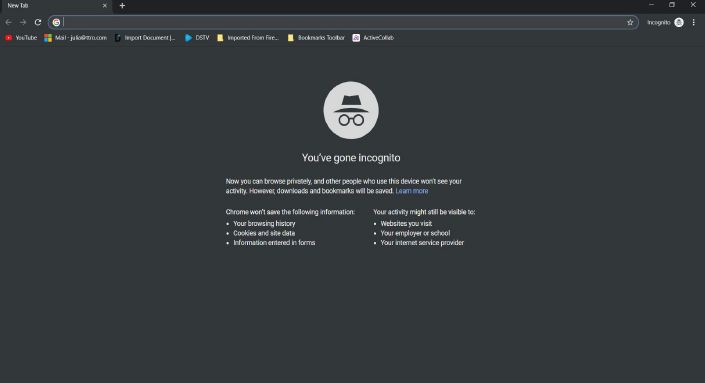
It’s the perfect time to take a look at one privacy feature that’s right in front of you: your web browser’s private browsing mode. Just what is it that makes private browsing private? Let’s take a look at the major browsers and see.
GOOGLE CHROME
Google Chrome calls it Incognito Mode, and you can tell you’re using it by looking for the “secret agent” icon in the top left corner of the window. Chrome also shows you a big, bold new tab page when you open an Incognito window. That’s it at the top of this post. In Incognito Mode, Chrome won’t keep track of the pages you visit, the data you enter into forms, or any searches you submit. It won’t remember what files you download, but those files will stay on your computer after you close the Incognito window. You’ll have to manually delete them if you want them gone. The same goes for bookmarks you create.
Example 7.2 How to use private browsing with Google Chrome
1. Click on the Open menu icon.
2. Click on New incognito tab. This will open a new private browser.
You can also open a private browser by pressing Ctrl+Shift+N.
 Activity 7.2
Activity 7.2
1.To create bookmarks, you can do the following:
a.Open your Google Chrome browser.
b.Create four bookmarks.
c.Pin your bookmarks on the browser.
1.A variety of plug-ins can be installed on web browsers.
a.Why would you use or need browser plug-ins?.
b.Give ONE common example of a browser plug-in.
 Activity 7.3
Activity 7.3
1.Which is NOT an example of a web browser?
a.Avast
b.Microsoft Edge
c.Google Chrome
d.Firefox
2.Choose a term or concept from Column B that matches the description in Column A. Write only the letter next to the question number.
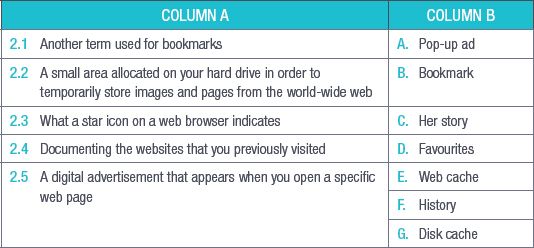
3.Define a bookmark.
4.State TWO disadvantages of adware, other than the fact that it might be annoying.
UNIT
7.3 Computer communications
In the first unit of this chapter, we discussed different types of digital communication, as well as their advantages and disadvantages. In this section, we will be taking a closer look at how these different types of digital communication can be used in order to communicate with others.
BLOGGING
A blog (shortening of “weblog”) is an online journal or informational website displaying information in the reverse chronological order, with the latest posts appearing first. It is a platform where a writer or even a group of writers share their views on an individual subject.
ADVANTAGES OF BLOGGING
- Enables you to write down your thoughts on anything of interest
- Very quick and easy to set up
- Easy and quick to update and add a new post
- People can leave comments on your blog
DISADVANTAGES OF BLOGGING
- Whatever you publish is available for everyone to see.
- Personal blogs may be biased
- Blogs can be time consuming
- People may leave rude an inappropriate comments
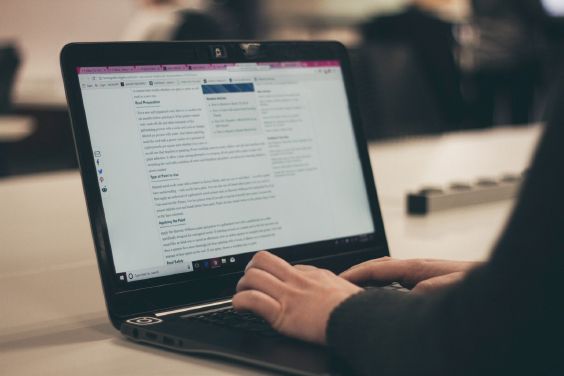
CREATING A BLOG, REGISTERING A BLOG SPACE AND PUBLISHING A BLOG
The easiest way to create a blog is to register a blog space using a free blogging service, such as WordPress or Blogger.com.
This not only enables you to create a blog with little effort; it also makes it easier for readers to find your blog as it is associated with the blogging platform.
The first step in creating your blog is to register a blogging space. This can be done in the following way:
1. Make sure you have an internet connection and a Gmail account. (Some services do not require a Gmail account, but do require an email account.) If you do not have a Gmail account, make sure to register a Google account. (The Google account includes a Gmail account.)
2. Go to the blogging service website by typing the URL into your browser, or by searching for the service in Google.
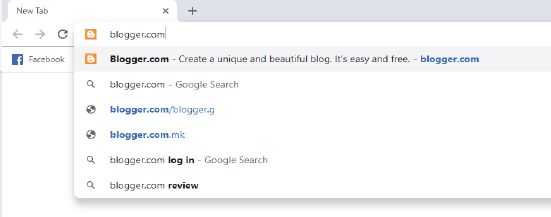
3. Once you are on the blogging service website, click Get Started, or Create Your Blog to register a new account. (The option will differ, depending on the website.)
4. Complete the account registration process by following the step-by-step instructions. This will include choosing an address for your blog.
Once you have registered your blogging account, you are ready to start creating your blog by writing your first post.

Something to know
Users will be able to find your blog by typing the address that you registered into their browsers.
To create posts for your blog by using a word processor, such as Microsoft Word, you can do the following:
1. Open Microsoft Word.
2. Click File and go to New.
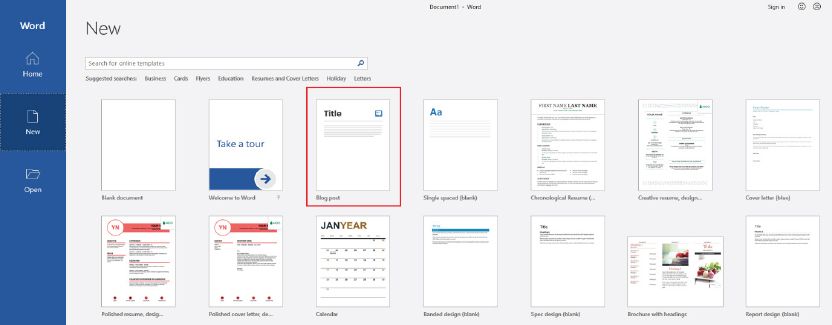
3. Select Blog post from the list of new documents. This will open a preview of the blog post.
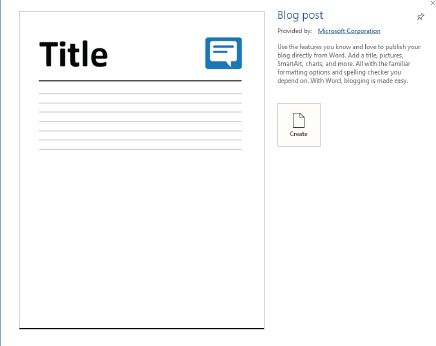
4. Click Create. This will open the Register a Blog Account window.
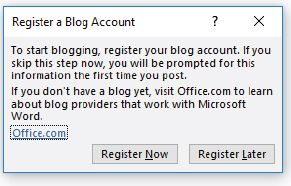
5. Click Register Now.
6. Select the service where you have registered a domain name from the blog drop-down list and click Next.
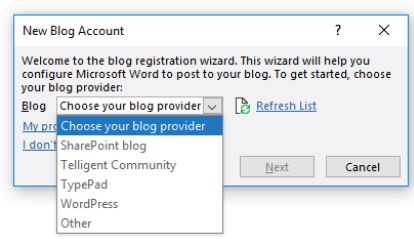
7. Fill in the details of your domain and click OK. This will allow you to start creating your blog in Word.
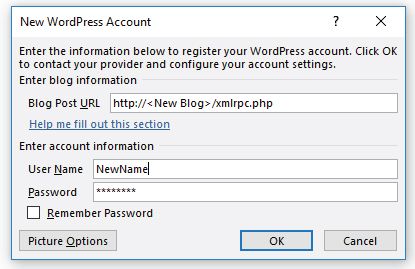
8. Once you have created content for your blog, click Publish.


Something to know
You do not need to use a blogging service in order to create a blog. You can also register your own domain name and use it to host your blog. This method has some advantages, such as allowing you the freedom to move your blog to a new domain while keeping all your readers. However, it should be noted that there will be some costs involved in hosting your own website.
VLOGGING
A video blog or video log, usually shortened to vlog, is a form of blog for which the medium is video, and is a form of web television. Vlog entries often combine embedded video (or a video link) with supporting text, images, and other metadata. A vlog is like a personal website or social media account where a person regularly posts short videos Entries can be recorded in one take or cut into multiple parts.
ADVANTAGES OF VLOGGING
- Easy to connect with an audience
- You do not have to create your own website
- Does not need to be professional
DISADVANTAGES OF VLOGGING
- Requires basic recording equipment
- Requires basic video editing knowledge
- Can be very time consuming
PODCASTING AND VODCASTING
Podcasting is a free service that allows internet users to pull audio files (typically MP3s) from a podcasting website to listen to on their computers or personal digital audio players. The term comes from a combination of the words iPod (a personal digital audio player made by Apple) and broadcasting. A podcast is an audio programme produced on a regular basis, delivered over the internet in a compressed digital format and designed for playback on computers or portable digital audio players, such as the ipod.
A vodcast is a podcast consisting of video recordings, instead of solely audio.
ADVANTAGES OF PODCASTING AND VODCASTING
- Good to listen to while travelling
- A good way to get a daily update
- Can be professional or relaxed
- Can be very informative
DISADVANTAGES OF PODCASTING AND VODCASTING
- Can be time consuming and difficult to make, especially scripted podcasts
- Needs a good reader, good information and good writing in order for it to be interesting
- Audience for podcasts is smaller
BEST PRACTICE
Podcasts or vodcasts can cover a variety of subjects; including novels, dramas, news, or even talk shows discussing daily events or the latest games. To help you start your very own podcast or vodcast, you can do the following:
- Ensure that you have enough time to script, record and edit the podcast or vodcast.
- Stay consistent with your uploads; schedule your updates so that listeners will know when new content will be posted.
- Be polite, and speak naturally and clearly.
- Choose topics about which you are passionate.
- Advertise your podcast or vodcast. Sharing the release and topic information on social media is a good way in which to obtain new listeners.
WIKIS
Wiki websites are a form of digital communication that are used to obtain and share information with other users. The website can be accessed and edited by any user across the world, so long as that person has a computer and an internet connection. Due to this reason, it is very important to verify any information obtained from a wiki.
ADVANTAGES OF WIKIS
- Anyone can edit the information and, therefore, is updated regularly
- Easy and free to use
- Can be accessed from any device that has an internet connection
DISADVANTAGES OF WIKIS
- Anyone can edit the information, which means it can lead to misinformation
- Open to spam and vandalism if not moderated
- Needs an active internet connection
The most famous wiki website is Wikipedia, an online encyclopaedia. However, there are many other wiki websites; each covering a specific topic.
RSS FEEDS
WHAT IS RSS?
RSS stands for “Really Simple Syndication”. It is a way to easily distribute a list of headlines, update notices, and sometimes content to a wide number of people. It is used by computer programs that organize those headlines and notices for easy reading.
WHAT PROBLEM DOES RSS SOLVE?
Most people are interested in many websites whose content changes on an unpredictable schedule. Examples of such websites are news sites, community and religious organization information pages, product information pages, medical websites, and weblogs. Repeatedly checking each website to see if there is any new content can be very tedious.
Email notification of changes was an early solution to this problem. Unfortunately, when you receive email notifications from multiple websites they are usually disorganized and can get overwhelming, and are often mistaken for spam.
RSS is a better way to be notified of new and changed content. Notifications of changes to multiple websites are handled easily, and the results are presented to you well organized and distinct from email.
HOW DOES RSS WORK?
RSS works by having the website author maintain a list of notifications on their website in a standard way. This list of notifications is called an “RSS Feed”. People who are interested in finding out the latest headlines or changes can check this list. Special computer programs called “RSS aggregators” have been developed that automatically access the RSS feeds of websites you care about on your behalf and organize the results for you. (RSS feeds and aggregators are also sometimes called “RSS Channels” and “RSS Readers”.)
Producing an RSS feed is very simple and hundreds of thousands of websites now provide this feature, including major news organizations like the New York Times, the BBC, and Reuters, as well as many weblogs.
RSS FEED PROVIDE THE FOLLOWING INFORMATION
RSS provides very basic information to do its notification. It is made up of a list of items presented in order from newest to oldest. Each item usually consists of a simple title describing the item along with a more complete description and a link to a web page with the actual information being described. Sometimes this description is the full information you want to read (such as the content of a weblog post) and sometimes it is just a summary.
GPS
GPS is a form of digital communication that uses satellite-based radio navigation in order to determine where you are in the world. This information can then be used to navigate to a new destination, or to let others know where you currently are.
ADVANTAGES OF GPS
- GPS is available from anywhere in the world
- GPS can be used to locate a person quickly and efficiently if he or she is in trouble
- GPS software is updated regularly to account for any change to the landscape
- GPS can be used to plan your route, get directions and find retail outlets
DISADVANTAGES OF GPS
- GPS devices use a lot of power, which requires that the battery be charged regularly
- GPS signal might be affected by weather, tall buildings and structures
- GPS accuracy depends of the strength of the signal; a weak signal can lead to inaccurate information, which is why we recommend that you always bring a map as backup
- GPS devices are expensive to purchase
In the past, users had to buy a GPS device, such as a TomTom, in order to receive and analyse signals from a satellite network. This is no longer the case. Modern smartphones come equipped with a built-in GPS, as well as navigating software, such as Google Maps.
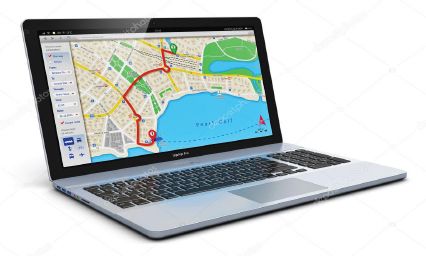
GEOTAGGING
Geotagging is the process of attaching geographical data (obtained using a GPS) to media and websites. This includes attaching latitude and longitude coordinates, timestamps, altitude, distance and place names to videos, photos, messages and QR codes.
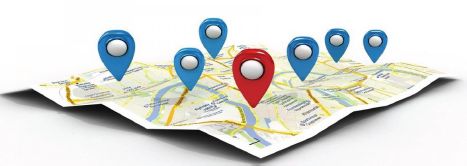

Something to know
Due to their ability to connect people, many of the world’s largest websites are social networking sites. This includes Facebook, Twitter and Instagram.
SOCIAL NETWORKS
A social networking service is an online platform that allows the user to communicate and share information with other users from around the world. In simple terms, it is a website that connects you to people by making friends and seeing what they are up to. You can usually also post pictures and share photos, videos and ideas with an individual (through direct message) or group of friends (through posting a message).
ADVANTAGES AND DISADVANTAGES OF SOCIAL NETWORKS
- Helps the user to stay connected with friends and family
- Helps the user to meet people with common interest
- Can be used to promote a product and find products in which you are interested
- Lets the user stay up to date with the latest news from around the world
ADVANTAGES AND DISADVANTAGES OF SOCIAL NETWORKS
- Cyberbullying is a growing problem in social media
- Information obtained from social media can be used to profile and discriminate against people
- Some people can get addicted to using and posting on social media
- Social media is a big source of false and misleading information
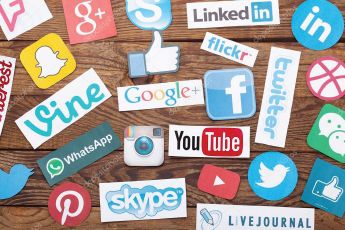
CREATING A NEW FACEBOOK ACCOUNT
You can create a social media account on a site such as Facebook, by going to www.facebook.com and completing the Create an account form. Once you are done, click Sign Up.
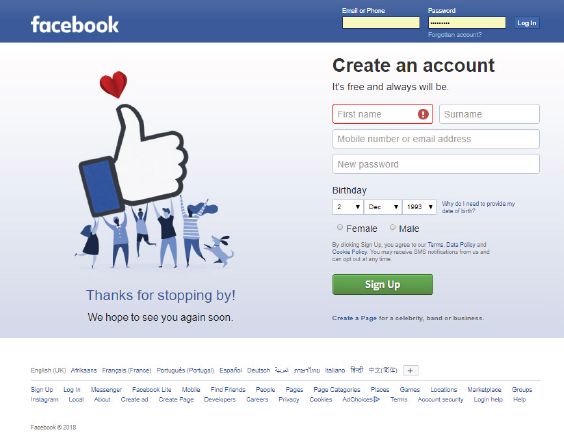
 Activity 7.4
Activity 7.4
1.Choose a term or concept from Column B that matches the description in Column A. Write only the letter next to the question number.
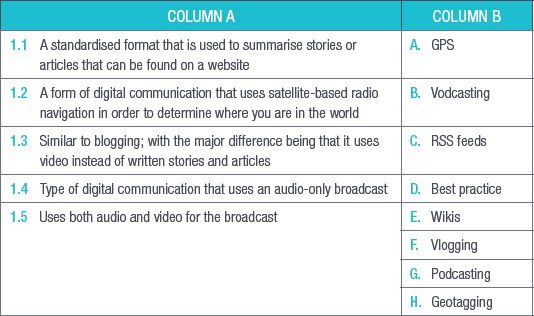
2.Christy wants to create a website to share her make-up tips with others. Do some research and write a short essay including the following information:
a.Advise Christy on what type of computer communication she should use.
b.Inform Christy of five advantages of this type of computer communication.
c.Inform Christy of five disadvantages of this type of computer communication.
3.Answer the following questions:
a.List three advantages and one disadvantage of blogging.
b.Explain how you would create and publish a blog using Microsoft Word.
c.Give one disadvantage of wiki websites.
d.Explain what geotagging is.
e.Explain how cyberbullying works and give an opinion on how to prevent cyberbullying, without taking away the technology.
UNIT
7.4 Communication devices
Throughout this chapter, we have taken a look at electronic communication, what it is, the different types, as well as its uses. In this section, we will be investigating some of the devices that you can use to communicate with your friends, family, colleagues, or even strangers over the internet.
COMPUTERS AND LAPTOPS
Desktops and laptop computers have become a big part of our everyday lives. They enable us to make use of a variety of different digital communication methods, including the following:
- Written communication, such as instant messaging and email
- Audio communication, such as VoIP
- Video communication, such as video conferencing
Computers can also be found in a variety of electronic devices where it enables the system to communicate with itself in order to function properly.
SMARTPHONES
The smartphone is a type of computer that people can carry in their pockets and is thousands of times more powerful than the computers that were used to put the first man on the moon. The smartphone can connect to the internet and can perform a variety of different functions, including the following:
- Making and receiving calls
- Sending and receiving written messages
- Sending and receiving audio messages
- Video conferencing
- Social networking
- GPS
- Listen to music
- Take photos and videos
- Play a variety of mobile games
WEARABLES
Wearables are a new category of computers, which consist of small devices that have been designed to be worn, or attached to your body. Examples of these include the following:
- Smartwatches: Smartwatches can be synced with your smartphone, allowing you to see your messages and calls on your watch.
- Smart clothing: Smart clothing is specially designed clothing to monitor a user’s behaviour, such as the heart rate and blood glucose levels.
- Fitness trackers: Fitness trackers allow users to record their daily activities, work-outs, heart rate, number of steps and number of calories burned. These trackers are promoted by healthcare companies.
TABLETS
Tablets are small hand-held computers that are smaller than a laptop. but bigger than a smartphone. Modern tablets work in a way very similar to that of smartphones. The main differences between the two are that tablets are bigger and are normally used for different activities. For example:
- Tablets are traditionally used by the whole family to watch shows at home
- Smartphones are used when the owner of the phone leaves home to communicate with others
 Activity 7.5
Activity 7.5
1.Choose a term or concept from Column B that matches the description in Column A. Write only the letter next to the question number.
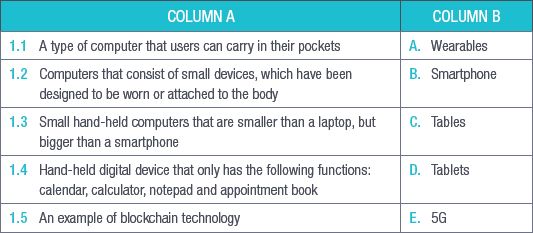
2.Answer the following questions:
a.What is the difference between a smartphone and a tablet?
b.Name and describe four functions of a smartphone.
c.Describe the three different digital communication methods that enable global connection.
REVISION ACTIVITY
QUESTION 1: MULTIPLE CHOICE
1.1Which of the following is a disadvantage of electronic communication? (1)
A.Fast and easy to use.
B.Can be used for a wide variety of applications.
C.People can become addicted to certain forms of digital communication.
D.Saves you money as it is cheaper than traditional communication methods.
1.2Which of the following is NOT proper netiquette? (1)
A.Show people on the internet the same respect you would show to them in real life.
B.Make sure your messages are clearly written and easy to understand.
C.When joining an existing conversation, speak about subjects that interest you.
D.Try to make useful contributions and help people out on the internet.
1.3Which of the following uses asynchronous communication? (1)
A.Email
B.Instant messaging
C.Video conferencing
D.VoIP
1.4Which web browser comes preinstalled on Windows XP? (1)
A.Microsoft Edge
B.Internet Explorer
C.Google Chrome
D.Safari
1.5Which of the following can be used to prevent a person from accessing dangerous content on the internet? (1)
A.Bookmarks
B.Private browsing
C.Website blockers
D.Caching
[5]
QUESTION 2: TRUE OR FALSE
Indicate if the following statements are TRUE or FALSE. Choose the answer and write true or false next to the question number Correct the statement if it is FALSE. Change the underlined word(s) to make the statement TRUE. (You may not simply use the word ‘NOT’ to change the statement.)
2.1It is proper etiquette to be careful about the things you say to people online. (1)
2.2When you write instant messages you must not use slang and symbols. (1)
2.3VoIP requires more bandwidth than instant messaging. (1)
2.4During VoIP mute yourself when you are not speaking. (1)
2.5You can import bookmarks from one web browser to another. (1)
[5]
QUESTION 3: MEDIUM QUESTIONS
3.1Which of the following types of electronic communication describes the disadvantages in the table below the best? (6)
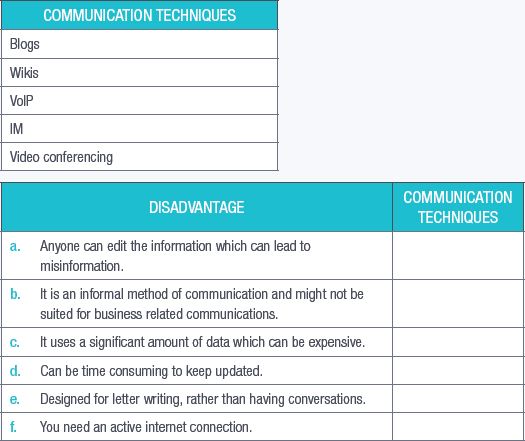
3.2Name two web browser features that you can use daily. (2)
3.3Describe three different digital communication methods that enables you to connect globally. (3)
3.4What is geotagging? Give an example of when you would make use of geotagging. (2)
3.5Briefly explain how companies can benefit from knowing your search history. (2)
[15]
TOTAL: 25
AT THE END OF THE CHAPTER

|
Previous
Chapter 6: System software and computer management
|
Table of Contents |
Next
Chapter 8: Social implications of e-communications and technologies
|

